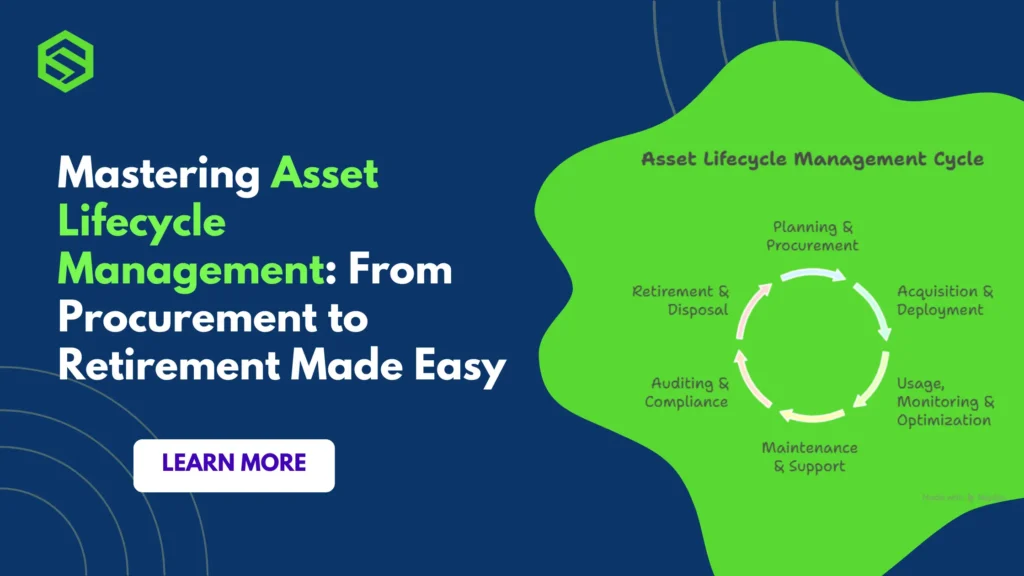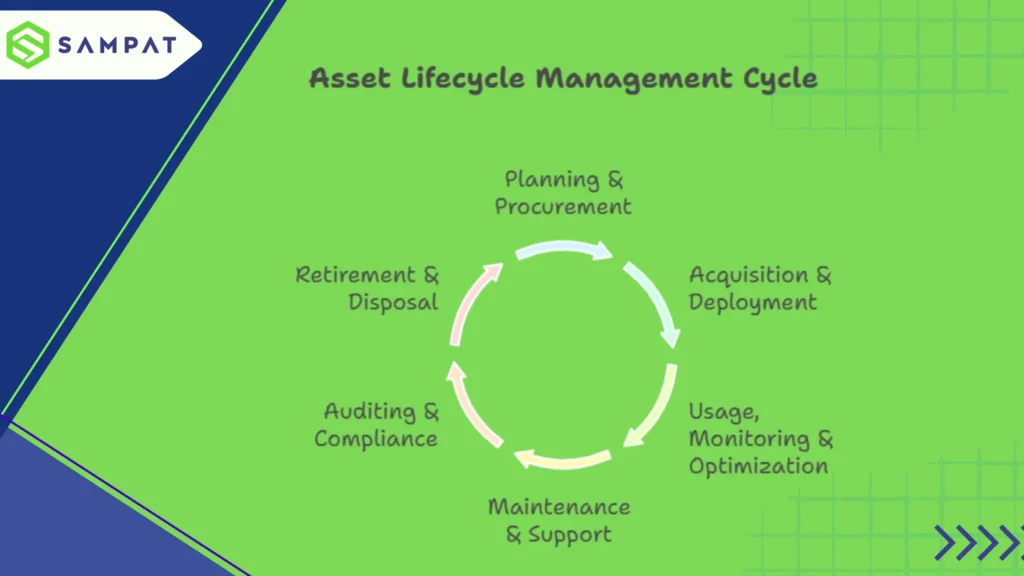
IT assets are the backbone of business operations. Whether it’s hardware like servers and laptops or software that powers daily tasks, every asset plays a crucial role in driving organizational goals. But simply acquiring assets isn’t enough — their full potential lies in how they’re managed throughout their lifecycle.
Asset Lifecycle Management (ALM) offers a structured, strategic way to handle each stage of an asset’s existence — from purchase to retirement. When paired with advanced asset tracking software or asset management software, businesses gain complete control over their resources, reduce costs, improve efficiency, and eliminate risks.
Let’s explore how organizations can master ALM and why it’s more critical than ever.
What Is Asset Lifecycle Management?
At its core, Asset Lifecycle Management (ALM) is the process of overseeing every stage of an asset’s journey — starting from procurement, going through deployment, usage, maintenance, and finally ending with retirement or disposal.
Rather than viewing assets as static purchases, ALM treats them as evolving components of the business. Effective management ensures every asset provides maximum value throughout its lifespan, while minimizing financial, operational, and security risks.
Organizations that neglect ALM often deal with:
- Wasted budgets due to redundant purchases.
- Compliance issues with licensing and regulations.
- Security vulnerabilities from unmanaged or outdated assets.
- Operational disruptions due to unplanned breakdowns or failures.
This is where modern asset tracking software become essential — providing real-time visibility, automation, and data-driven insights at every stage.
Why Mastering Asset Lifecycle Management Matters
Before diving into each stage, it’s important to understand why effective lifecycle management is no longer optional:
- Optimized resource utilization: Ensures every asset is fully used and not sitting idle or underutilized.
- Reduced operational costs: Avoids unnecessary replacements and reactive maintenance expenses.
- Improved compliance: Simplifies audits, licensing management, and regulatory adherence.
- Enhanced security: Tracks assets closely to reduce data breaches and cybersecurity threats.
- Better decision-making: Data-driven insights allow for smarter budgeting, forecasting, and strategic planning.
With the right technology like SAMPAT’s Asset Management Software, managing these factors becomes far more efficient and accurate.
The Stages of Asset Lifecycle Management
Mastering ALM requires a clear understanding of its various stages. Each phase has unique challenges and opportunities:
1. Planning & Procurement
Every asset’s journey begins with a business need. Organizations assess their current and future requirements, budgets, and operational goals.
During procurement:
- Conduct thorough needs assessments.
- Evaluate assets for compatibility, scalability, and cost-effectiveness.
- Select trusted vendors and negotiate favorable terms.
Asset management system simplifies this process by offering data-backed forecasts, ensuring that only necessary assets are purchased at the right time.
2. Acquisition & Deployment
After procurement, assets move into deployment where they’re tagged, installed, configured, and assigned to users.
Here, asset tracking software plays a vital role:
- Barcodes, RFID tags, or QR codes are assigned.
- Deployment records are automatically updated.
- Assignments to specific employees, departments, or locations are documented.
With Management Software, deployment becomes quick, error-free, and fully trackable, ensuring no asset goes unaccounted.
3. Usage, Monitoring & Optimization
Once deployed, assets enter active use — the longest phase of their lifecycle.
During this stage:
- Performance must be monitored regularly.
- Utilization should be optimized to avoid idle assets.
- Capacity and workload balancing ensures extended lifespan.
Asset management software provides real-time utilization reports, helping IT teams redistribute workloads or retire unused resources, maximizing ROI.
Example: If certain servers are overloaded while others sit idle, workload balancing can extend hardware life and improve overall efficiency.
4. Maintenance & Support
Preventive maintenance is the key to reducing costly downtime. Without a system in place, it’s easy to miss routine checkups.
Automated maintenance scheduling within asset tracking software ensures:
- Timely software updates and security patches.
- Proactive hardware inspections.
- Consistent service logs for auditing purposes.
With automated reminders, businesses reduce human error and avoid expensive repair emergencies.
5. Auditing & Compliance
Maintaining precise asset documentation is essential for both internal reviews and external regulatory audits. Without centralized data, audits can become stressful and time-consuming.
With robust asset management software, organizations can:
- Instantly generate compliance reports.
- Track license renewals and contract expirations.
- Maintain complete audit trails for regulators and stakeholders.
This significantly simplifies regulatory compliance with standards like ISO 27001, GDPR, HIPAA, or local data protection laws.
6. Retirement & Disposal
No asset lasts forever. When an asset reaches end-of-life:
- Data must be securely wiped.
- Environmental regulations for disposal must be followed.
- Retired assets may be resold, recycled, or donated.
Improper retirement poses serious risks — especially with sensitive company data. SAMPAT ensures your disposal process follows best security and environmental practices.
Book a complimentary demo to experience these features

Key Benefits of Asset Lifecycle Management
By adopting a holistic ALM strategy, businesses unlock multiple advantages:
1. Cost Savings:
Avoid unnecessary purchases.
Extend asset lifespan through better maintenance.
Make informed budgeting decisions.
2. Improved Security:
Eliminate ghost assets.
Reduce entry points for cyberattacks.
Maintain strict control over software licensing.
3. Greater Efficiency:
Automate manual processes.
Enable real-time asset visibility.
Free up IT teams for higher-level tasks.
4. Compliance Confidence:
Centralized audit trails.
Stay ahead of regulations.
Simplify documentation.
The Role of Asset Management Software
So how do modern organizations actually implement ALM successfully?
The answer lies in adopting purpose-built asset management software or asset tracking software that handle:
- Centralized asset inventory
- Real-time asset tracking (hardware and software)
- Automated procurement and deployment workflows
- Predictive maintenance scheduling
- Compliance reporting
- Retirement protocols
Platforms like SAMPAT eliminate the complexity, making it easy for businesses of any size to gain complete control over their IT assets.
Future Trends in ALM
As businesses evolve, so do ALM practices. Emerging trends include:
- AI-driven predictive insights: Anticipate maintenance requirements and potential asset breakdowns in advance.
- Automation & Workflows: Reducing human involvement in routine tasks like procurement, patch management, and renewals.
- Sustainability Focus: Eco-friendly disposal and recycling to meet corporate social responsibility goals.
- Remote Asset Management: Managing global and hybrid workforces through cloud-based ALM platforms.
Conclusion:
Mastering Asset Lifecycle Management is no longer a complex, manual task. With the right tools, businesses can streamline procurement, monitor usage, maintain peak performance, and retire assets securely — all while saving money and protecting sensitive data.
By leveraging powerful solutions Asset Management Software and requesting a free demo, organizations take the first step toward maximizing every asset’s value from day one to retirement.
Don’t let your valuable assets fall through the cracks. Take control. Optimize your lifecycle management today!
Frequently Asked Questions
What is the difference between asset retirement and disposal?
Retirement marks an asset as inactive but still owned, while disposal removes it from records through sale, recycling, or destruction.
How do you record a disposal of an asset?
Disposal is recorded by updating the asset register, documenting disposal method (sale, recycle, scrap), and adjusting financial records for depreciation and removal.
What is asset disposition?
Asset disposition is the formal process of retiring, selling, recycling, or securely destroying an asset once it’s no longer useful. It ensures compliance and data security.
What are the key KPIs for each asset lifecycle stage?
Retirement marks an asset as inactive but still owned, while disposal removes it from records through sale, recycling, or destruction.
How to build an asset procurement checklist for IT assets?
A procurement checklist should include business needs, vendor evaluation, budget approval, warranty/SLAs, compliance requirements, and lifecycle tracking setup.



